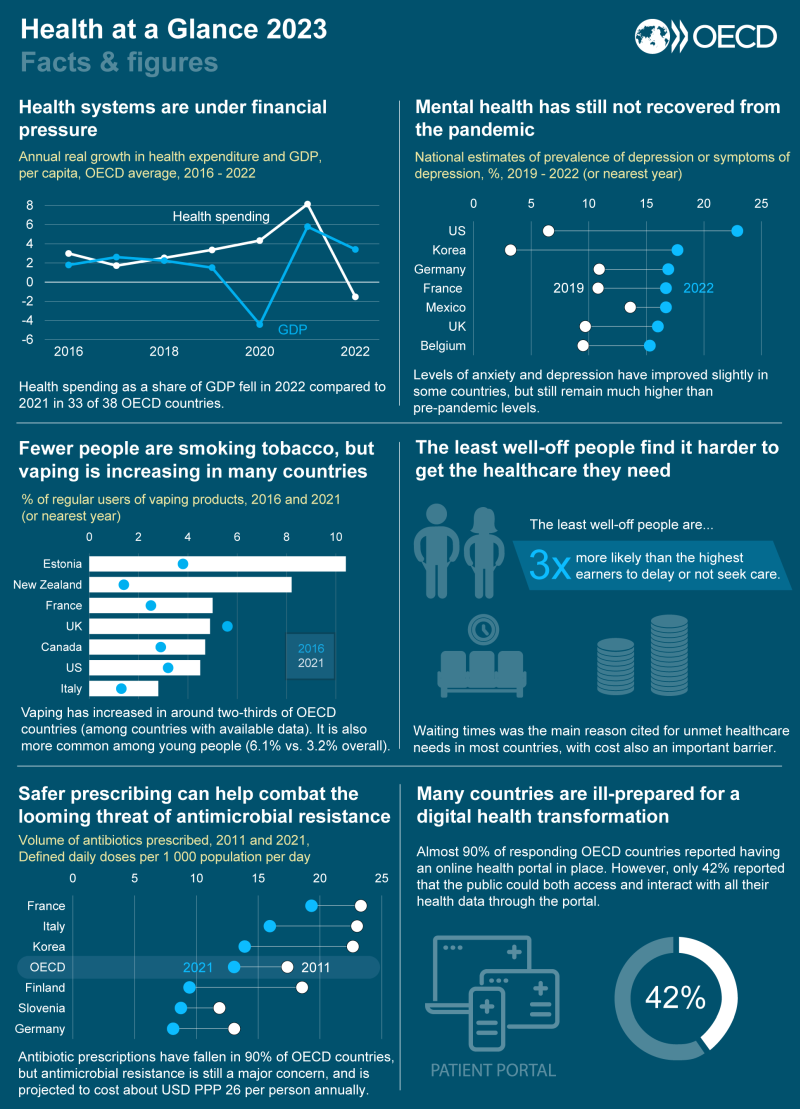Health at a Glance 2023

Health at a Glance 2023
OECD Indicators
Published on November 07, 2023 Latest available edition in: French, German, Korean, Spanish
| Foreword | |||||||||||||||||||||||||||
| Reader’s guide | |||||||||||||||||||||||||||
| Executive summary | |||||||||||||||||||||||||||
| Key facts and figures (infographic) | |||||||||||||||||||||||||||
| Indicator overview: Country dashboards and major trends | |||||||||||||||||||||||||||
| Digital health at a glance | |||||||||||||||||||||||||||
|
Health status11 chapters available
|
|||||||||||||||||||||||||||
|
Access: Affordability, availability and use of services12 chapters available
|
|||||||||||||||||||||||||||
|
Quality and outcomes of care13 chapters available
|
|||||||||||||||||||||||||||
|
Health expenditure9 chapters available
|
|||||||||||||||||||||||||||
|
Health workforce11 chapters available
|
|||||||||||||||||||||||||||
|
Ageing and long-term care11 chapters available
|
|||||||||||||||||||||||||||

Digitalisation of health systems can significantly improve performance and outcomes
Health systems in the OECD are under renewed financial pressure, owing to competing priorities for public funding, according to a new OECD report. The 2023 edition of OECD Health at a Glance estimates that healthcare spending in OECD countries corresponded to 9.2% of GDP in 2022, down from 9.7% in 2021. While this exceeds the 2019 levels, in 11 OECD countries, health spending as a share of GDP in 2022 was lower than in 2019.
READ MORE
Press & overview
- Press release: Digitalisation of health systems can significantly improve performance and outcomes
- Press release (in French)
- Watch the press conference
- Launch webinars: see presentations in English, German, Japanese and Spanish
- Executive Summary / Résumé en français
- Infographic
- Access the full report
Country-specific findings
- Australia
- Austria
- Belgium
- Canada: in English and in French
- Chile
- Colombia
- Costa Rica
- Czech Republic
- Denmark
- Estonia
- Finland
- France : in English and in French
- Germany
- Greece
- Hungary
- Iceland
- Ireland
- Israel
- Italy
- Japan
- Korea
- Latvia
- Lithuania
- Luxembourg
- Mexico
- Netherlands
- New Zealand
- Norway
- Poland
- Portugal
- Slovak Republic
- Slovenia
- Spain
- Sweden
- Switzerland
- Türkiye
- United Kingdom
- United States
Indicators by theme

Digital Health
Digital health has enormous potential to transform health systems. However, many countries are struggling to maximise the value from digital health because technologies and the data environment are often outdated and fragmented.
©OECD
LEARN MORE...
Life expectancy, mortality and well-being
Core population health indicators show that societies have not yet fully recovered from the pandemic, with many people still struggling mentally and physically.
©OECD
LEARN MORE...
Smoking, alcohol, obesity and air pollution
Unhealthy lifestyles and poor environments cause millions of people to die prematurely. Smoking, harmful alcohol use, physical inactivity and obesity are the root cause of many chronic conditions.
©OECD
LEARN MORE...
Affordability, availability and use
Despite universal health coverage in most OECD countries, barriers to access remain, with gaps in financial protection and sometimes long waiting lists.
©OECD
LEARN MORE...
Quality and outcomes of care
Quality of care is improving in terms of safety and effectiveness, and more attention is being placed on patient-reported outcomes and experiences.
©OECD
LEARN MORE...
Health spending
Spending on health fell to 9.2% of GDP in 2022, down from 9.7% in 2021. On average this is above the share of GDP in 2019. However, in 11 countries, health spending as a share of GDP in 2022 was lower than in 2019.
©OECD
LEARN MORE...
Health workforce
The health and social care workforce continues to grow, but concerns about shortages are becoming more acute.
©OECD
LEARN MORE...
Pharmaceutical sector
Pharmaceuticals account for around one-sixth of health spending on average. Increased uptake of generics and biosimilars can increase value-for-money in health systems.
©OECD
LEARN MORE...
Ageing & long-term care
Health systems should adapt to meet the needs of an ageing population, including a greater demand for labour-intensive long-term care and more integrated, person-centred care.
©OECD
LEARN MORE...